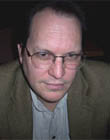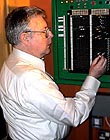|
|
This topic comprises 6 pages: 1 2 3 4 5 6
|
|
Author
|
Topic: Dolby Clones
|
|
|
Steve Guttag
We forgot the crackers Gromit!!!

Posts: 12814
From: Annapolis, MD
Registered: Dec 1999
|
 posted 04-08-2006 10:01 PM
posted 04-08-2006 10:01 PM




I like most of the techs that have been in the business for some time now have worked with most if not all of those products you listed.
To properly answer your question, one has to remember that Dolby came in the Cinema market based on their noise reduction technology, not the surround sound thing. The Dolby 364/E2 system allowed MONO films to have noise reduction with wide bandwidth reproduction with equalized soundheads and speakers.
The next processor, the CP100 really was aimed at 70mm venues...again applying noise reduction technology. Surround Sound technology was an OPTION for the CP100.
The first step to the "SVA" process was just the three stage channels, not the surround sound technology. There were 5 surround adapters for the CP100 (named SA1-SA5). The SA4 was the final one for just 35mm SVA...the SA5 being only needed for 70mm Stereo Surround.
The CP50 was the encono processor that was really Dolby's first entrance into just 35mm optical stereo and again the surround sound technology was not there at first. Ever noticed that the terminal blocks that state "output to surround adapter" and "input from surround adapter"?
Dolby's first incarnation of the SVA process not only was just 3-channel but it did some minimal ducking and raising of the center channel (as well as Left/Right) to try a primitive steering of the audio for dialog. But if you play a film with one of these original stereo decoders (Cat 110 for the CP50, Something like the Cat 82 or 84 for the CP100..I forget) and all three stage channels will be playing all of the time.
When surround sound came in, it was in the form of the Cat 116 which used the Sansui QS decoder chip. However, the Cat 116 did not communicate with the Cat 110 there were two completely different processes going on here. Dolby did have a delay on the Cat 116 to mask the mistracking of the surround decoding.
EPRAD mimicked this model of the system with their StarScope line of products.
Early StarScopes even used Cat 22 Dolby cards for the noise reduction. I'm not aware of any steering on the stage channels since they had you set up the Center hotter, particularly in the dialog region with the EQs. Eprad not only forgot the delay on the surrounds but also the volume control for them! Thus, you could turn your volume down to zero the surrounds will STILL be playing! Later units with a triple ganged pot fader to address that problem but it was a LONG time before they added a delay to the surrounds.
Eprad's surround decoder also had a nasty on/off gate that when it mistracked (quite often) with have the surrounds cut-in/out on you...it wouldn't have been as bad if they had the delay.
In those early years, EPRAD was really the only competitor to Dolby. In fact, a little piece of trivia, the World Premier of Star Trek the Motion Picture played on an EPRAD Starscope at the K-B MacArthur. When Star Trek II: The Wrath of Kahn opened at the K-B MacArthur, a brand new CP200 was installed for the 70mm presentation (70mm up until that point was still using the old Simplex XL system at that theatre).
One of the reasons EPRAD got some positions in our area is that Dolby could not supply CP50s in time for some releases, EPRAD could. It was not just a cost thing.
Back then Dolby also had their people scan the newspaper listings for people advertising Dolby Stereo when they did not in fact have Dolby Cinema equipment. Dolby has always been protective of their brand name. One way exhibitors cheated on this is to purchase some Dolby equipment so in a multiplex of say 6 screens, there might be one or two Dolby CP50s and the rest were off brand so Dolby would have to prove that the film was not being shown on the Dolby screens.
The company I worked for, K-B Theatres, had a mixture of CP50s and EPRADS and all were mounted in mobile racks that had everything you needed, monitor, amplifiers and processor. Those theatres that were 4-track mag capabile (most of them) had an interface installed so these racks could be patched in. If a Dolby film were to open at one of those theatres, the service company was dispatched to move one of those racks from one theatre to the other (now remember, this was back when Singles were the majority of the theatres and those booths were WAY up there and no elevators...just stairs). It was policy to leave the last reel prepped and ready for the technician to verify the sound system was working properly after the move. Think about it, a tech would go into theatre A after midnight, snatch the Dolby or Eprad rack, schlep it down 3 or more flights of stairs, load it into the van, move it to theatre B, schlep it up 3 or so flights of stairs, hook it up, perform an A and B chain, then run the last reel of the film to verify everything was good.
Remember, this was in a time where the Dolby Stereo releases were on the order of 10-20% of all releases...not that many. Rack movement happened mostly during the summer and winter times.
I believe Jack Cashin (Ultra Stereo Labs) came from Dolby so they came after.
Norm Schneider of SMART was the JBL rep in the 70s but they were there pretty early in the Dolby Stereo times too.
Kintek came on the scene around 1980. They were not in the stereo business, they were in the psudostereo business. Remember, 80-90% of all films were mono back then. Thus the sales pitch is that you can use your expensive stereo/surround system 100% of the time, not just 10-20%.
Kintek was an outgrowth of dbx. If you look at the original Kintek "3-box" systems (that horrid yellow color), the KT-21 had more than a passing resemblance to the dbx 3BX dynamic range expander. Same package, same knobs, same display. It was refined in its range of expansion and applied the same priciples to films as it did for records (what the 3BX was known for). In fact, this box is still nice thing for running older mono films to provide a bit of single-ended noise reduction and a bit more fuller sound in a modern cinema.
The KT22, the stereophonyiser was nothing more than a better than average comb filter box to give the left and right speakers something to do...it did have a connector to have it provide steering between left/right and Center, if you had the KT-24.
The KT24 was the surround and Sub Bass unit. This unit was also the best of its kind. This box looked at the signal, determined if it was seeing dialog or music/effects and based on that would turn the surrounds on/off and also tell the KT22 to raise/lower Left/Right to keep the dialog hard center.
When the 3-box set up is done well, it does better than it should and far better than other synths that were made by SMART and USL.
Kintek didn't have an SVA system until the KT-700 which came out around 1984/85. That did not have the KT750 module available at first either. The KT700 was still a means for a theatre to have 100% use of their sound system. However by 1985 the percentage of stereo films were on the rise. When the KT750 module came out, then I saw them (KT700) going in as stand alone units.
So I think I've address most of your questions...Dolby was really first in what we think of as the modern SVA process, the competitors did come out and there were false advertising by some.
| IP: Logged
|
|
|
|
|
|
|
|
|
|
|
|
|
|
|
|
|
|
|
|
|
|
|
|
|
|
|
|
|
|
All times are Central (GMT -6:00)
|
This topic comprises 6 pages: 1 2 3 4 5 6
|
Powered by Infopop Corporation
UBB.classicTM
6.3.1.2
The Film-Tech Forums are designed for various members related to the cinema industry to express their opinions, viewpoints and testimonials on various products, services and events based upon speculation, personal knowledge and factual information through use, therefore all views represented here allow no liability upon the publishers of this web site and the owners of said views assume no liability for any ill will resulting from these postings. The posts made here are for educational as well as entertainment purposes and as such anyone viewing this portion of the website must accept these views as statements of the author of that opinion
and agrees to release the authors from any and all liability.
|

 Home
Home
 Products
Products
 Store
Store
 Forum
Forum
 Warehouse
Warehouse
 Contact Us
Contact Us




 Printer-friendly view of this topic
Printer-friendly view of this topic











![[Big Grin]](biggrin.gif)

![[Smile]](smile.gif) )
)
![[Roll Eyes]](rolleyes.gif)
![[Cool]](cool.gif)
![[Razz]](tongue.gif)
![[Wink]](wink.gif)
![[Eek!]](eek.gif) .
.
![[bs]](graemlins/bs.gif)





